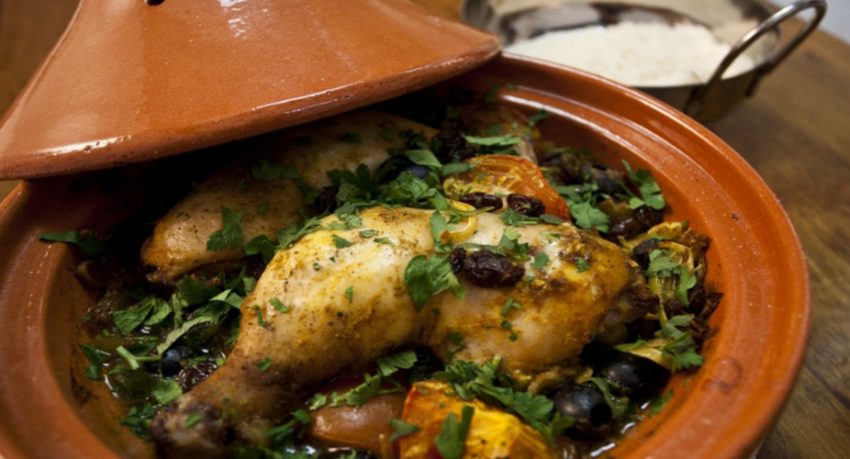Food in Morocco plays an important role in traditional life. From weddings to baptisms to circumcisions, it is the basis of social gatherings and celebrations. From couscous to tagines and pastilles, the delicate flavors are a blend of tastes of many civilizations. Arab, Berber, Middle Eastern, French and Jewish are just some of the influences on what is today recognized as Moroccan cuisine.
Over the centuries, the chefs of the royal kitchens refined the cuisine to create local mouth-watering dishes to titillate our taste buds. Apricots, dates, figs, and raisins local foods while almonds, pine nuts, and pistachios are used extensively. Spices such as cinnamon, cumin, turmeric, ginger, saffron, and mint lend an exotic flavor. And mint tea is the favored drink, with freshly squeezed juices a close second.
A truly traditional Moroccan dish is a tagine, a stew of vegetables with poultry or beef and dried fruit. The fruit is added towards the end to give an overall sweetness to the dish… The vegetables are set around the meat, which is placed in the center of the pot together with the fruit. The tagline is then covered and cooked slowly over a charcoal stove (called kanoun). Tagines also contain salted or preserved lemons, giving them a unique flavor that can’t be replicated using fresh lemons. Traditionally, the tagine is served with couscous, rice or bread. When eating, start on the outside with the vegetables, working your way to the meat at the heart of the dish.
Here is a recipe to get you started on a traditional tagine:
Chicken Tagine with Prunes and Almonds 1 chicken, cut up into 6 pieces 170 g (6 oz) dried prunes, chopped fine 60 g (2 oz) whole, blanched almonds 1 large white onion, finely chopped 2 cloves of garlic, crushed A teaspoon powdered ginger 1 teaspoon powdered cinnamon A teaspoon turmeric 1 teaspoons ground cumin 2 tablespoons vegetable oil salt and freshly ground black pepper to taste
The day before, prepare the chicken marinade. Wash the chicken in salted water and drain. Mix crushed garlic with 1 tbsp salt to make a paste. Rub into the chicken and then rinse under running water until the chicken no longer smells of garlic. Drain and set aside. Rub the chicken pieces with salt, cumin, and pepper and let stand for 1 hour.
Cover the prunes with cold water, add the cinnamon and bring to the boil. Cover and simmer for 30 minutes or longer – until the prunes are tender.
Place the chicken pieces in a 5-quart deep casserole over medium heat and add the chopped onion, turmeric, ginger, salt, pepper, and almonds. When the almonds are brown, remove with a perforated spoon and drain on kitchen paper. When the chicken is browned, cover with water just so the chicken pieces are covered and bring to the boil. Reduce heat and simmer, covered, for 30 minutes.
After 30 minutes, add the prunes and some of the prune water to the casserole and continue cooking until the chicken and prunes are very tender.
